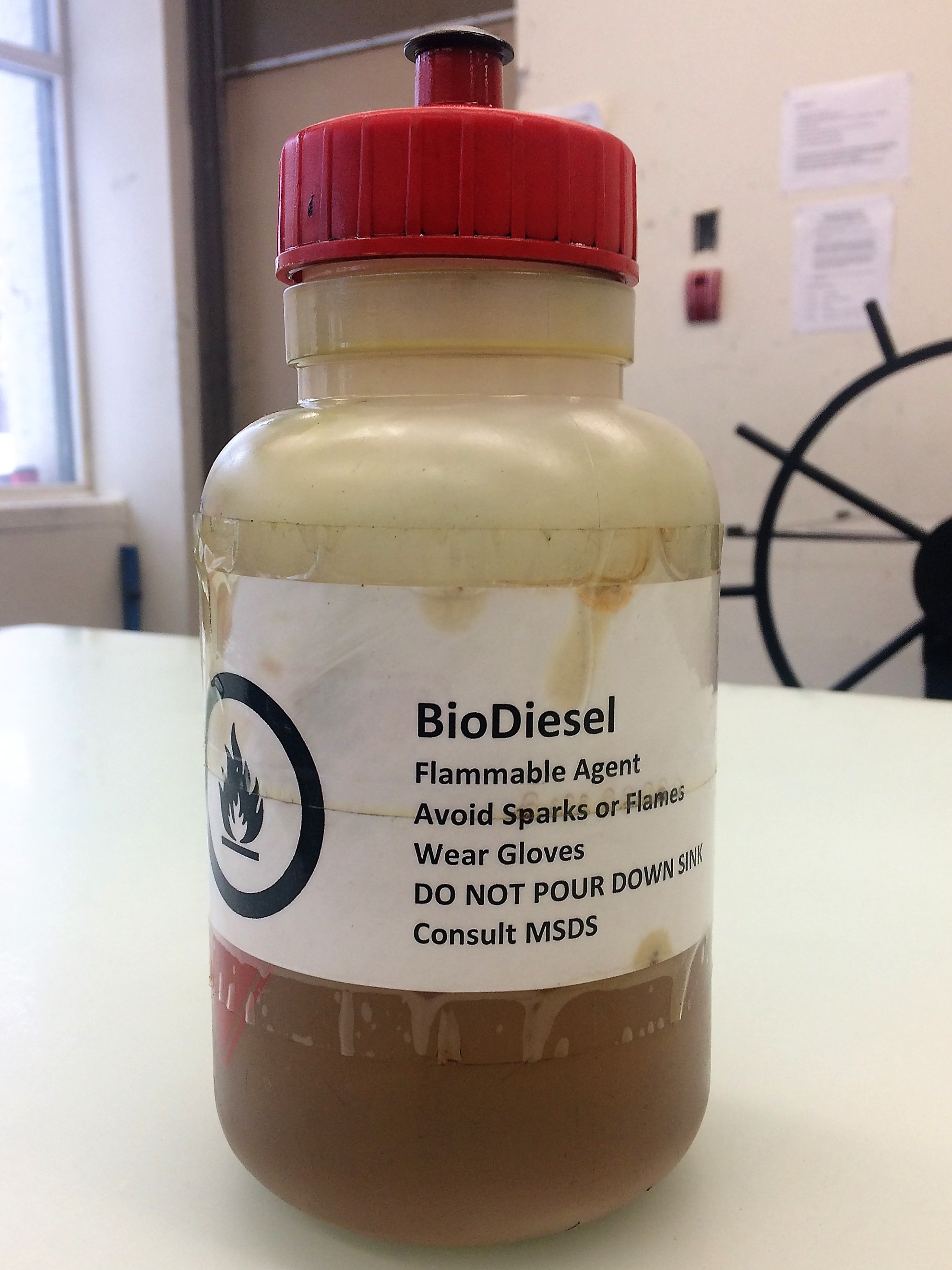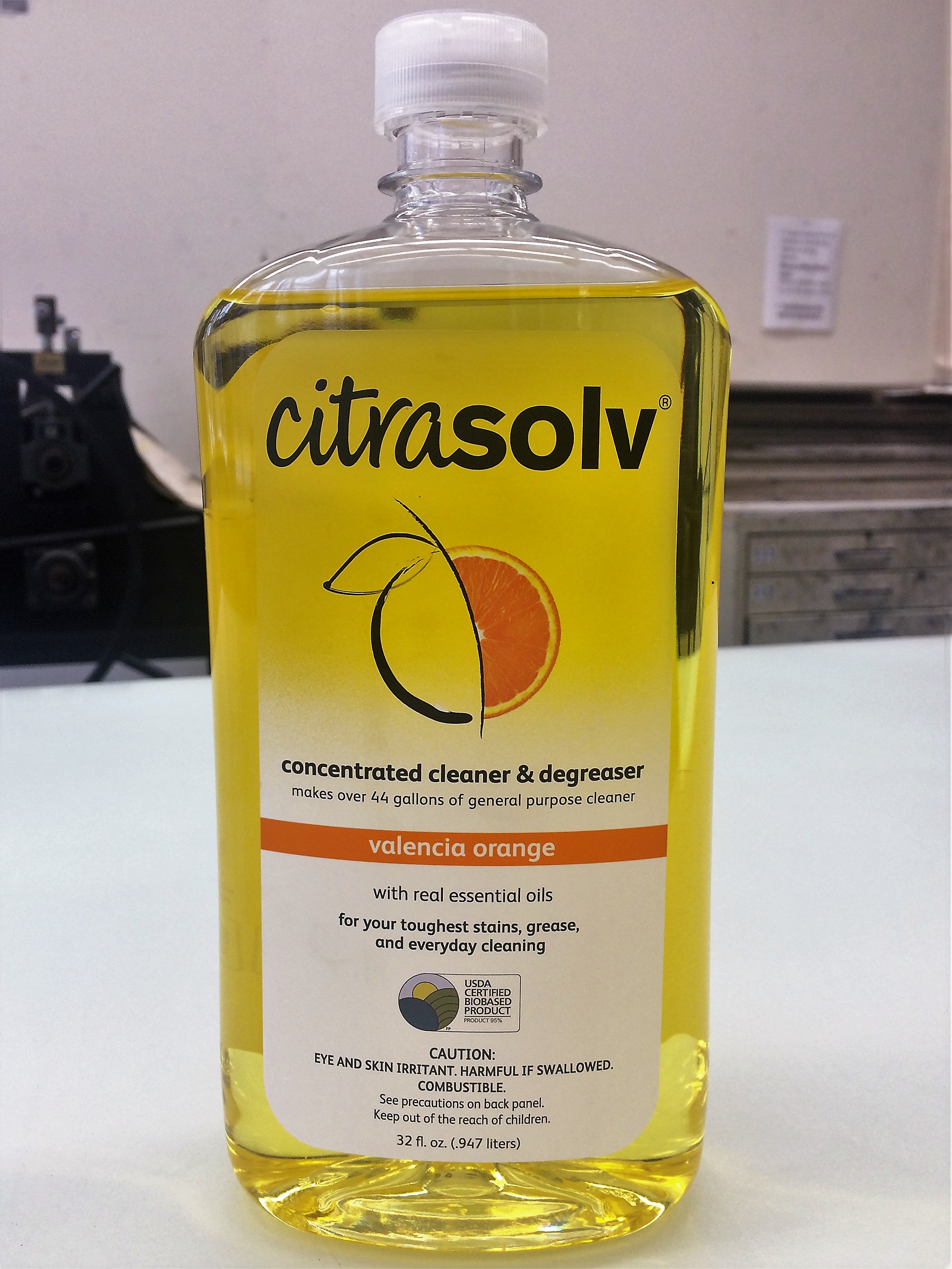Introduction
Safer Printmaking
Often the term "non-toxic" printmaking is used. A completely non-toxic way of working with the chemicals used in printmaking is not possible, as chemicals are needed in creating the image of cleaning the plate, which are reactive & possibly harmful. Terms, such as “safer printmaking,” "healthier printmaking" or "less-toxic printmaking" better express that chemical procedures are less dangerous compared to those in traditional printmaking. Only such techniques as rubbing and Japanese-style woodcut printing with paste inks can be called non-toxic.
“I stopped using the term ‘non-toxic’ after printmakers called me asking if it was okay to decorate cakes, or paint bodies with Akua inks. I am more comfortable using the term ‘safer’. I find labels and terms like ‘organic’, ‘green’ and ‘non-toxic’ are too misleading because there are no true regulations on using them." -Susan Rostow – Akua Inks
"I have very similar struggles with the phrase 'non-toxic'. It is a misnomer, yet it has become synonymous with the type of printmake we do. I have used 'safer' in the past, but find it a wimpy word. I really haven't found the right word to describe our practices. Lately, I've been using 'green' in quotes, because it implies safer without the disputable 'non-toxic' label. Maybe it's time to make up a new word!" -Liz Chalfin - Zea Mays Studio, MA, USA
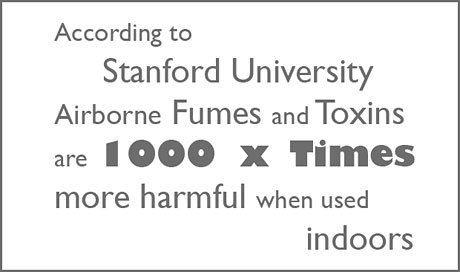
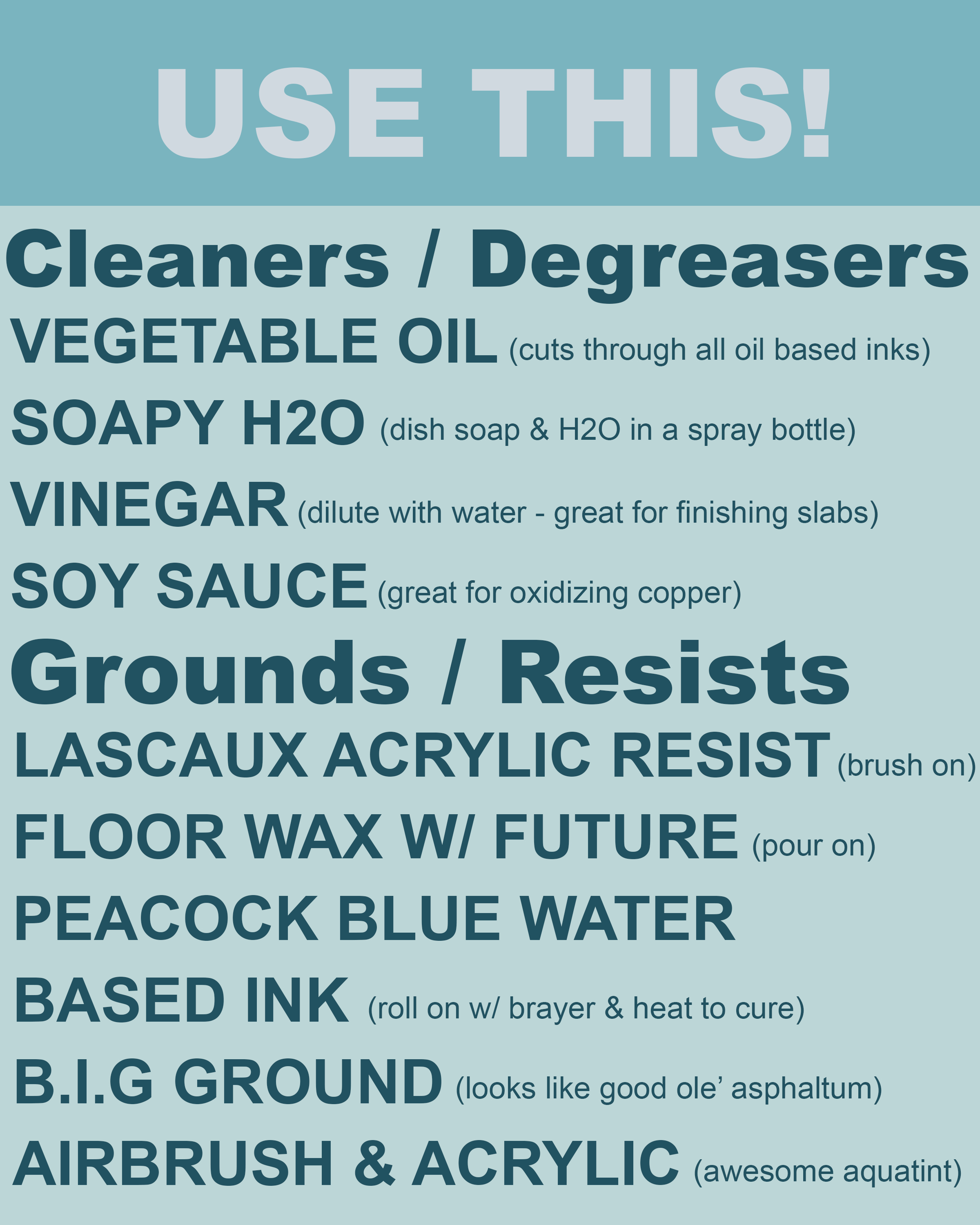
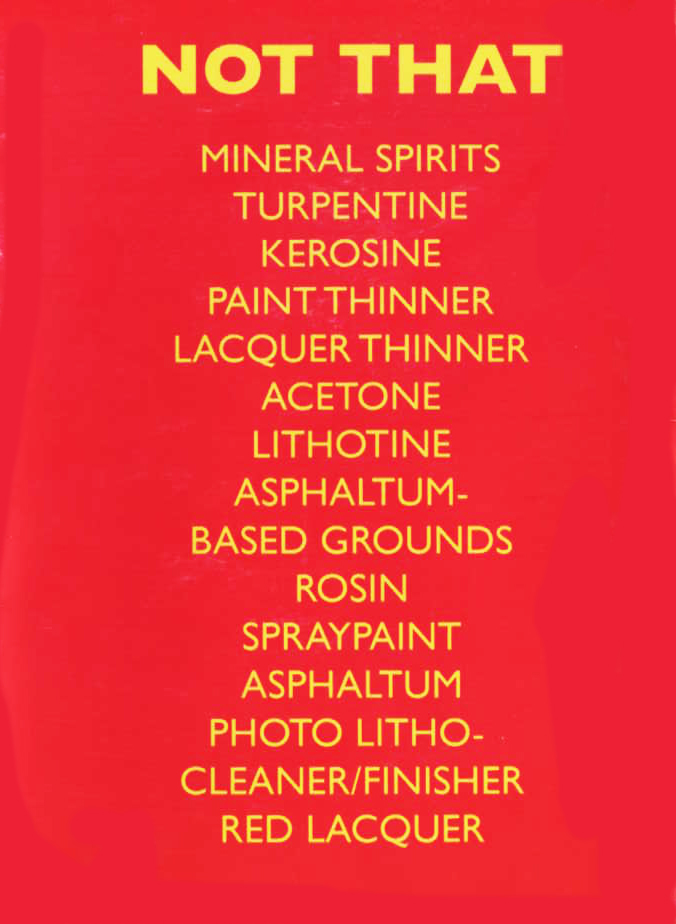
Safer Cleaning
There are three ways toxic materials can enter the body:
- by inhalation
- by ingestion
- or through the skin
Preventing inhalation is the most difficult as using exhausts or masks will overcome this problem only partly. Some gas, vapor, or aerosol will still be left in the air you and the people around you inhale. What you do not inhale will pollute the environment.
Instead of using all kinds of equipment it is better to fight the problem at the source. Introduction of Vegetable Cleaning Agents (VCA) as cleansers for printing plates, brushes, metal, glass and plastic objects in general will 'solve' most studio related health problems, and is a true contribution to a cleaner environment.
Vegetable Cleaning Agent (VCA)
"Vegetable Cleaning Agent" (VCA) is a generic name for a group of chemical compounds made of a vegetable oil and an alcohol, so called 'fatty acid esters'; Brand names such as Estisol, Prifer, Vegeol, Eco-V-Wash, Avisol VCA, Bio-Solv, Bio diesel etc. These are not volatile, thus you cannot inhale it.
VCA is good for:
- Printmakers, painters, sculptors, and silver smiths.
- water-based intaglio printing inks
- removing printing ink, wax, oil, vaseline and wax-containing etching grounds
- cleaning woodblocks for relief printing
- rollers
- stone and lithography plates
VCA is not good for:
- screenprinting: as it has no effect in cleaning the dried inks from the screens.
- water-based relief printing inks and acrylic paints
- dried and hardened oil-based inks apart from softening these.
VCA health problems:
- Prevent skin and eye contact, rinse with water after contact.
- Although VCAs do not produce any fumes they will dissolve the fat in your skin. It is also possible, with prolonged or chronic contact, that surface layers of your skin will start peeling off. Therefore, always wear gloves in handling VCA.
- Do not ingest VCA. If ingested, rinse your mouth with a lot of water, drink a lot of water and see a doctor.
- Clean your hands and mouth before eating, drinking, or smoking.
General Safety
- Do not use VCA for cleaning your skin. Although it is not volatile, VCA will dissolve the tallow which protects the skin and may cause it to peel off. Rub your hands thoroughly with salad oil, also good for the skin, clean with a rag and wash with a mild soap. Wear rubber gloves in cleaning with VCA.
- VCA rather slowly penetrates inks, paints and wax-containing grounds, but on the other hand you need only a small amount since it does not evaporate and stays active. Give it long enough to work (for instance, let etching plates stand overnight covered with VCA) and meanwhile spend your time on doing something else. Repeat the cleaning with VCA once or twice if necessary; for instance, with deeply etched plates containing large amounts of ink. VCA will stay active for a long period, although it will look dirty after a while with a layer of silt on the bottom of the tray. It does not evaporate, so only what sticks to your plates and blocks is taken out. To prevent silt coming onto or into your plate, put a metal grid into the tray; the silt will be under it and the VCA above.
- VCA is environmentally safe: it does not evaporate and the product can be broken down by bacteria. However, if you want to clean your tray filled with VCA, treat the contents as chemical waste, because the remains of inks and grounds may be harmful to the environment. Wash the soap suds down the drain; remains of VCA are degraded quickly in the sewer. Graphic studios having abundant deposits should use an overflow.
- Mixtures of VCA and High Boiling Solvents (the heavier kinds of volatile organic solvents) are available and cheaper than VCA alone. The High Boiling Solvents take some more time to evaporate but are as toxic as the lighter kinds.
In our experience printing plates, brushes and rubber rollers are cleaner using VCA than other solvents. You need far less of it than of other solvents from, 1/4th to 1/10th in some cases. You can leave it on your dry lithographic stone without any effect at all, something which certainly cannot be done using lithotine etc.
It takes a while to get used to cleaning with VCA, because of the differences from volatile solvents. Also cleaning itself takes a little more time. You should learn anew to clean your plates and tools using VCA.
Most important is that VCA does not evaporate. You cannot inhale it and thereby harm your mucous membranes, lungs and central nervous system, as happens when inhaling volatile organic solvents. Neither is VCA corrosive and so will not damage your printing plates or equipment.
Warning:
- Never use VCA as a thinner for your inks or paints. It does not evaporate nor oxidize and therefore has a negative effect on the drying of inks and paints.
- Never let soap come into your VCA. The soap will emulsify the VCA so it cannot be used again. In cleaning your plates and blocks first use VCA, then soap and finally water and never the other way around.
- Never spill VCA into the machinery of your press. As it does not dry or evaporate it will dissolve the grease.
Safer Printmaking Cleaning - A Word of Caution about Volatile Organic Compound
There are several institutions in Canada including the University of Saskatchewan, NASCAD University, OCAD University, Queens University, and University of Alberta that have successfully made cross-overs to non-toxic vegetable cleaners. These and other teaching institutions as well as collective and private printmaking studios have replaced Varsol (and other petroleum based cleaners) with safer printmaking cleaners such as Estisol or soy-based vegetable cleaners. However, there is a learning curve when making the transition from petroleum-based to vegetable-based solvents. Vegetable-based solvents can destroy rollers if not removed properly and cleaned up completely.
Risks of Unsafe Cleaning With Volatile Organic Solvents (VOS)
Organic Psycho Syndrome
Cleaning printing plates, paint brushes and other equipment is still often done with Volatile Organic Solvents (VOS). Some varieties of VOS are: turpentine, white spirit, lithotine, benzene, citro-solve, turpentine, gasoline, etherical oils, and many others. VOS dissolves ink and etching ground but only as long as it is fluid. It evaporates quickly whereafter, new solvent has to be added. Evaporation does not mean the solvent is gone. On the contrary, it is in the air around you and you inhale it with every breath you take. When in your lungs, the vapor is readily taken up in the blood stream and transported to the brain in twenty seconds. Your brain, and the rest of your nervous system, consists mainly of fat. VOS will dissolve this fat and thereby cause disturbances in your functioning, like electrical wire that has been stripped of its insulation. The malfunctioning of your brain shows largely through a combination of psychic or mental problems. The condition is called "Organic Psycho Syndrome" (OPS). Inhaling VOS for the first time, may create feelings of irritation, aggression, restlessness, euphoria (as in sniffing glue to get a high), irritation of the respiratory system, coughing, smarting eyes, confusion and headache.
The most important indications of a lighter form of OPS are: dizziness, sleeping problems (either too much or not enough), fatigue, feelings of depression or melancholy, loss of interest in daily activities, loss of concentration, slowness in activities, feelings of drunkenness. On the weekend and during holidays these complaints usually diminish or may even disappear.
With long-term or chronic exposure brain dysfunction increases and is continuous. Common complaints are: forgetfulness, motor disturbances such as convulsions and forms of paralysis, insomnia, aggression, changing mood, depression and melancholy. Ultimately, there is permanent brain damage, which causes definitive change of personality, permanent loss of memory, paralysis and dementia. Some kinds of volatile solvents affect certain organs specifically, such as the liver or the kidneys, or may cause anaemia, infertility or leukemia. For further information go to the website of the Organic Psycho Syndrome Association.
Health & Safety Procedures
Sample Studio Procedures at the University of Saskatchewan
1. Mandatory student health and safety supply kits
For foundation, intermediate and senior printmaking students. Students must pay for their own personal health & safety equipment (respirators, nitrile gauntlet, disposable gloves)
2. Mandatory requirement for use of respirators
Required use of organic mist vapour respirator in all studio areas during processes where its use is appropriate. Such as in the spray booth, screen washout booth, screen reclaiming processes, etc.
3. Respirator fit test and maintenance workshops
All print students are required to take respirator fit testing, and to care and maintain all devices.
4. New "no food policy" in all printmaking studio areas.
5. Introduction of safer and safer Estisol 150 and Estisol 242.
From Denmark, Estisol esters are an alternative to volatile solvents. These esters have replaced traditional lithography materials such as Asphaltum (a known carcinogen) and Lithotene. The air quality in the lithography studio has improved dramatically.
6. Introduction of Baldwin Intaglio Grounds (BIG) etching methods.
This ground is removed by Citrastrip. Asphaltum (a known carcinogen) used as hard and soft ground has been eliminated form the studio. The air quality in the etching studio has improved dramatically.
7. Introduction of water and soya based inks (Akua) for intaglio, relief and monotypes.
8. Future Floor Wax/India Ink airbrush to replace Asphaltum as an intaglio stop out.
9. Introduction of biodiesel, mineral oil and water/vinegar for ink clean-up.
Other past solvents from the studio have ben eliminated from the studio is new policy.
11. Introduction of safer photo-etching solar plates
Photo-printmaking Intaglio that are exposed in the sun and processed with tap water.
12. Introduction of new waste reduction system for studio rag use
New contained cans labeled with: semi-used or waste (to reduce waste)
Video
The Safety Video
(Source: Printmakers Compendium by Tara Cooper)


